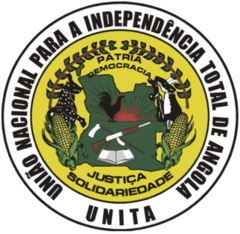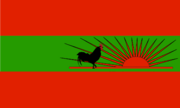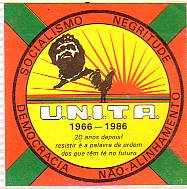UNITA facts for kids
Quick facts for kids
National Union for the Total Independence of Angola
União Nacional para a Independência Total de Angola
|
|
|---|---|
 |
|
| Leader | Adalberto Costa Júnior |
| Founder | Jonas Savimbi |
| Founded | 13 March 1966 |
| Split from | National Liberation Front of Angola |
| Headquarters | Luanda |
| Youth wing | Revolutionary United Youth of Angola |
| Women's wing | Angolan Women's League |
| Armed wing | FALA (until 1993) |
| Ideology |
|
| Political position |
|
| National affiliation | Supreme Council for the Liberation of Angola (1972–1975) United Patriotic Front |
| Regional affiliation | Democrat Union of Africa |
| International affiliation | Centrist Democrat International |
| Seats in the National Assembly |
90 / 220
|
| Party flag | |
 |
|
The National Union for the Total Independence of Angola (Portuguese: União Nacional para a Independência Total de Angola, abbr. UNITA) is a major political party in Angola. It was started in 1966. UNITA first fought for Angola's independence from Portugal. This war lasted from 1961 to 1975.
After independence, UNITA fought against another group called the People's Movement for the Liberation of Angola (MPLA). This led to the Angolan Civil War (1975–2002). This war was a big part of the Cold War, where different countries supported opposing sides. UNITA received help from countries like China, the United States, and South Africa. The MPLA got support from the Soviet Union and Cuba.
For many years, UNITA got money from diamond mines in Angola. These diamonds helped fund their war efforts. After its leader, Jonas Savimbi, passed away in 2002, UNITA stopped fighting. It then became a political party that takes part in elections. Today, Adalberto Costa Júnior is the leader of UNITA.
Contents
How UNITA Started
Jonas Savimbi and Antonio da Costa Fernandes created UNITA on March 13, 1966. This happened in a place called Muangai in the Moxico province of Angola. About 200 other people were there at the founding event. UNITA's first attack against the Portuguese rulers was on December 25, 1966.
Savimbi was first part of another group, the National Liberation Front of Angola (FNLA). UNITA later moved its main base to Jamba in southeastern Angola. Many of UNITA's early leaders came from the Ovimbundu ethnic group. At first, their ideas were similar to Maoism, focusing on rural rights. But they soon changed and worked with Portuguese officials against the MPLA. Later, in the 1980s, UNITA became allies with the United States and South Africa. After the 1992 elections, the U.S. stopped supporting UNITA.
Independence and Civil War in Angola
After Portugal left Angola in 1974–75, the MPLA and UNITA started fighting each other. This began the Angolan Civil War. The MPLA leader, Agostinho Neto, became Angola's first president. The MPLA, with help from the Soviet Union and Cuba, defeated the FNLA.
UNITA was almost destroyed in November 1975. But it managed to survive and set up its own government in Huambo. UNITA grew stronger with help from South Africa and then the U.S. in the 1980s. The MPLA controlled the cities and oil fields. UNITA, however, controlled much of the country's interior. The civil war caused the deaths of up to 300,000 Angolans.
UNITA as a Fighting Group
In the 1980s, Savimbi worked to get more support from the U.S. He received advice from a group in Washington, D.C., called The Heritage Foundation. This group had strong ties with the U.S. government. Experts from The Heritage Foundation visited Savimbi in Angola. They offered him advice on military and political strategies.
In 1986, U.S. conservatives convinced President Ronald Reagan to meet Savimbi. Reagan supported Savimbi's efforts. He believed UNITA's success was important for his foreign policy. This policy aimed to support groups fighting against communism around the world.
Under Savimbi, UNITA became a very effective fighting group. The U.S. State Department said UNITA controlled "vast areas of the interior" of Angola. Savimbi was known for surviving many attempts to defeat him. He was called "Africa's most enduring bush fighter."
American conservatives saw UNITA's success as proof that the U.S. was winning the Cold War. They said that supporting groups like UNITA was working. However, critics argued that this support made regional conflicts worse. Both UNITA and the Angolan government faced criticism for their actions during the war.
The 1980s and Changing Support
In 1983, UNITA gained attention for taking 66 Czechoslovak civilians. Some of them were held for about 15 months before being released. Fighting continued until 1989. At that time, Cuba withdrew its troops that were helping the MPLA.
As the Cold War seemed to be ending, questions arose about U.S. support for UNITA. Some in the U.S. Congress wanted to stop the aid. Soviet leader Mikhail Gorbachev also discussed U.S. support for UNITA with President George H. W. Bush. This put more pressure on the U.S. to end its help.
UNITA leaders were encouraged to demand "free and fair elections" as a condition for a ceasefire. When the MPLA first refused, UNITA increased its military pressure. They claimed the MPLA was afraid of losing an election. An agreement was later made for foreign troops to leave Angola. This also led to Namibia becoming independent from South Africa. Savimbi, however, felt he was not fully consulted on this agreement.
Eventually, a ceasefire was agreed upon. The MPLA leader, José Eduardo dos Santos, and his party gave up their Marxist ideas. They agreed to free and fair elections, as UNITA had demanded. However, UNITA and its supporters were still unsure, as the MPLA kept strong ties with the Soviet Union.
The 1990s and Peace Efforts

After the 1991 Bicesse Accords, elections were held in 1992. Both Savimbi and dos Santos ran for president. Savimbi did not win enough votes in the first round. He then questioned the election results and returned to fighting. The conflict restarted in October 1992.
During this time, UNITA's vice-president, Jeremias Chitunda, and other officials were killed. This event is known as the Halloween Massacre. UNITA then moved its base from Jamba to Huambo. Savimbi's choice to restart the war was costly. Many of his U.S. allies urged him to continue with the elections. His decision also strained UNITA's relationship with U.S. President George H. W. Bush.
The United Nations (U.N.) placed an embargo on UNITA. This was to stop them from getting weapons. Reports showed that UNITA was still funding its war by selling diamonds. These diamonds were later called "conflict diamonds." This led to more U.N. actions to stop this trade. In late 1992, the U.S. government recognized the Angolan government and stopped supporting UNITA.
Another agreement, the Lusaka Protocol, was made in 1994 to form a unity government. U.N. peacekeepers arrived in 1995. But UNITA left the agreement in 1998, saying the MPLA had broken its promises. A group called UNITA Renovada broke away from Savimbi's UNITA. Many more soldiers left UNITA in 1999 and 2000.
In 1999, the MPLA launched a military attack called Operation Restore. This greatly weakened UNITA as a regular army. UNITA had to go back to using guerrilla tactics.
The 2000s and the End of the War
The Angolan civil war finally ended after Savimbi passed away. He was killed in an ambush on February 22, 2002. His death surprised many Angolans. Many had grown up during the war and seen Savimbi survive many attempts to capture or kill him.
Six weeks after Savimbi's death, in April 2002, UNITA agreed to a ceasefire with the government. Under a special agreement, about 350,000 UNITA soldiers and their families were gathered in camps. This program helped them return to normal life. In August 2002, UNITA officially gave up its armed forces. It then focused all its efforts on being a political party. Even with the ceasefire, there are still strong political differences between UNITA and the MPLA.
After Savimbi, António Dembo became leader but passed away soon after. Then, Isaías Samakuva won the election to become UNITA's new president. In November 2019, Samakuva resigned. Adalberto Costa Júnior became the new president, with Arlete Leona Chimbinda as vice-president.
International Support for UNITA
UNITA received help from several countries around the world. These included Bulgaria, Egypt, France, Israel, Morocco, China, North Korea, Saudi Arabia, Zaire, and Zambia.
United States Support
During the Reagan administration, high-ranking U.S. officials met with UNITA leaders. These meetings included the head of the Central Intelligence Agency (CIA) and the Secretary of State. They met with UNITA leaders in Washington, D.C., and Morocco. Even though a law called the Clark Amendment limited U.S. involvement, the U.S. continued to help UNITA.
The U.S. government also encouraged other countries to help UNITA. These countries included Israel, Morocco, Saudi Arabia, South Africa, and Zaire. In 1983, the U.S. and South Africa agreed to send weapons to UNITA. The U.S. also traded weapons with South Africa for information about the civil war.
Savimbi gained support from important American conservatives. They helped him become more well-known in Washington. They also promoted sending American weapons to UNITA. These conservatives met with Savimbi in Angola. President Ronald Reagan praised Savimbi as a "freedom fighter." He spoke of Savimbi winning a victory that would "electrify the world." However, others saw Savimbi as a leader who only wanted power.
After the 1992 Angolan general election, UNITA lost U.S. support. It was then only supported by South Africa. This support ended after apartheid ended in South Africa. When Nelson Mandela became president in 1994, South Africa stopped helping UNITA. Mandela's party had supported the MPLA.
Election Results
Presidential Elections
| Election | Party candidate | Votes | % | Result |
|---|---|---|---|---|
| 1992 | Jonas Savimbi | 1,579,298 | 40.07% | Lost |
| 2012 | Isaías Samakuva | 1,074,565 | 18.67% | Lost |
| 2017 | 1,818,903 | 26.68% | Lost |
|
| 2022 | Adalberto Costa Júnior | 2,756,786 | 43.95% | Lost |
National Assembly Elections
| Election | Party leader | Votes | % | Seats | +/– | Position | Result |
|---|---|---|---|---|---|---|---|
| 1992 | Jonas Savimbi | 1,347,636 | 34.10% |
70 / 220
|
New | Opposition | |
| 2008 | Isaías Samakuva | 670,363 | 10.39% |
16 / 220
|
Opposition | ||
| 2012 | 1,074,565 | 18.66% |
32 / 220
|
Opposition | |||
| 2017 | 1,790,320 | 26.70% |
51 / 220
|
Opposition | |||
| 2022 | Adalberto Costa Júnior | 2,756,786 | 43.95% |
90 / 220
|
Opposition |
See also
 In Spanish: Unión Nacional para la Independencia Total de Angola para niños
In Spanish: Unión Nacional para la Independencia Total de Angola para niños
- African independence movements
- David Chingunji
- Jorge Sangumba
- Kafundanga Chingunji
- RENAMO, a similar group in Mozambique also supported by Apartheid South Africa


